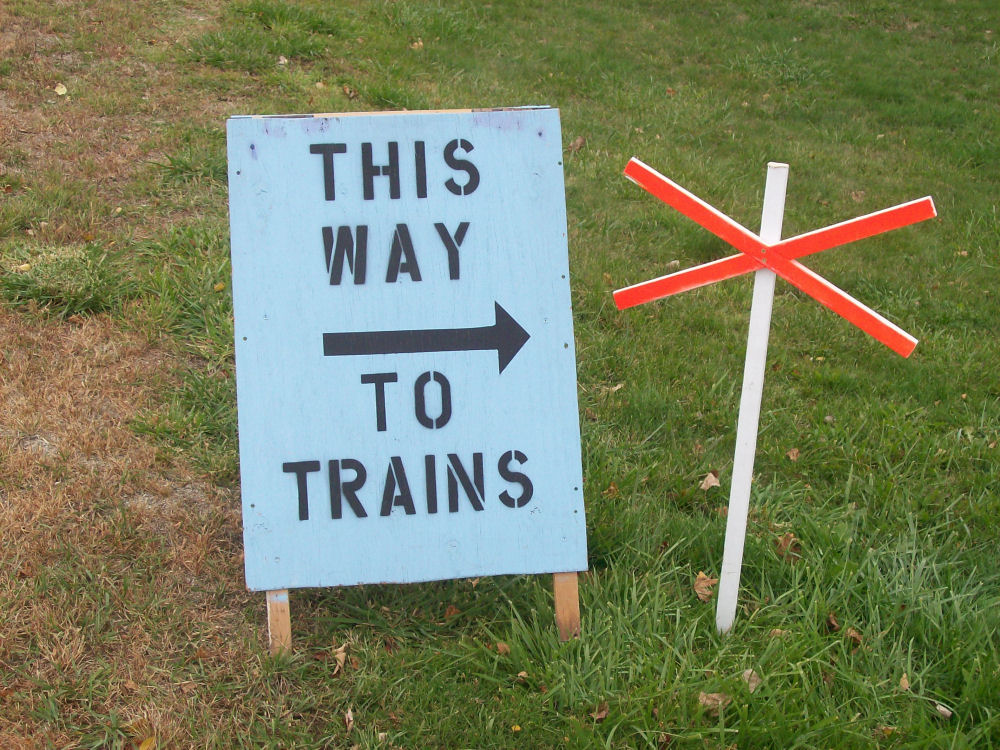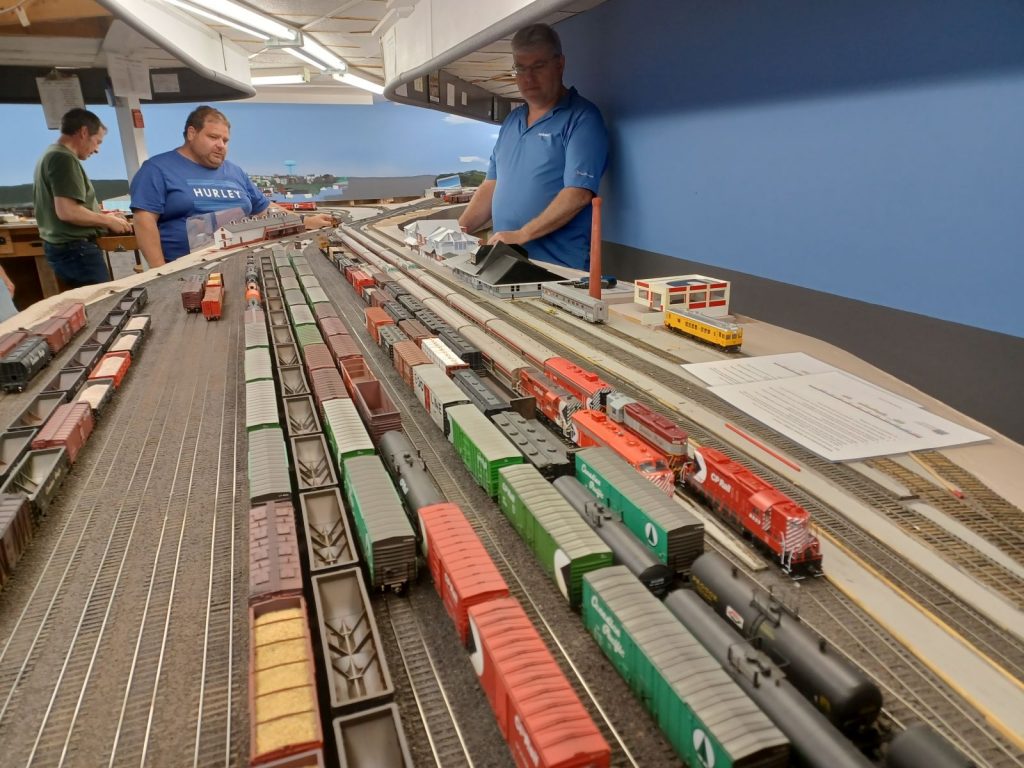HANDLING OF SWITCHES AND DERAILS
Note: When spring or dual control switches are operated by hand, they are then hand operated switches and rules governing hand operated switches apply.
104. HAND OPERATED SWITCHES – Except where switchtenders are stationed, conductors are responsible for the position of switches manually operated by them and members of their crews. Employees are not relieved of responsibility in properly handling switches.
Switches must at all times be secured. Main track switches must be lined and locked for main track when not in use. Yard switches that are equipped with locks must be lined and locked in normal position after having been used.
A main track switch must not be left open unless in charge of a member of the crew or a switch tender.
After a switch has been turned the points must be examined and the target or light observed to know that the switch is properly lined.
When a train or engine is clear of the main track waiting for an approaching train, the crew on engine must, when practicable, see that the switches in front of the engine are properly lined for the approaching train.
A train or engine must not foul a track until switches connected with the movement are properly lined, or in the case of automatic or spring switches the conflicting route is known to be clear.
A member of the crew of a train occupying the main track at a meeting or passing point will, when practicable, open the switch for the approaching train and protect it until relieved by a trainman of the other train or a switchtender.
When a train is closely approaching or passing over a main track switch, employees must keep not less than twenty feet from the switch stand, and on single track must, in addition, when practicable, stand on the opposite side of the track.
The position of the switch at the end of two tracks is normal when set for trains leaving single for two tracks.
When a train or engine turns out from the main track at any point, the switch must not be restored to its normal position until the train or engine has cleared the fouling point.
If it is known or suspected that the points, or any parts of a switch are damaged or broken, the switch must be protected, section foreman notified, and report made to the proper authority from the first available point of communication.
Both switches of a crossover must be open before a train or engine starts to make a crossover movement and the movement must be completed before either switch is restored to normal position. When a crossover is to be used the switch in the track on which the train or engine is standing must be opened first.
104A. SPRING SWITCHES – When a trailing movement is stopped before passing entirely through a spring switch, the movement must not be reversed nor slack taken in until the switch has been properly set by hand.
When a train or engine is stopped by fixed signal governing movement over a spring switch in the facing point direction, the points must be examined, and if not properly closed and cannot be closed by hand, they must be spiked in proper position before being used. After movement over switch has been made spike must be removed and superintendent notified immediately. If switch points are found in proper position, train will be governed by indication of signal.
Trains or engines must stop and examine main track spring switches before making facing point movements over them unless receiving a signal indication permitting them to proceed.
NOTE: Wherever the words “train dispatcher” appear herein, they apply to the employee performing the duties.
104B. DUAL CONTROL SWITCHES – When a train or engine is stopped by a signal governing movement over a dual control switch, if no conflicting movement is evident, a member of the crew must immediately communicate with the train dispatcher and be governed by his instructions. Such instructions must include information as to the route to be used. These instructions must be in writing and repeated to ensure correct understanding.
When a train or engine is required to move over a dual control switch under a Stop indication, movement must not be made until after selector lever has been taken out of “power” position and placed in “hand” position. Hand throw lever must be operated until switch points are seen to move with the movement of hand throw lever. Switch must then be lined for the route to be used. Selector lever may be restored to “power” position and locked as soon as leading wheels have moved onto the switch points.
When switching is to be done over a dual control switch, the switch may be operated manually by a member of the crew after authority to do so and work and time limits have been obtained from the train dispatcher as prescribed by Rule 266. Selector lever must then be placed in “hand” position and hand throw lever operated until switch points are seen to move with the movement of hand throw lever. Selector lever must be left in “hand” position until switching movements have been completed.
When selector lever is placed in “hand” position, all signals governing movements over the switch will display STOP indication and the train or engine granted work and time limits may consider the indication of such signals suspended, and movements may be made on hand signals until switching completed and selector lever is restored to “power” position and locked. Train dispatcher must be notified when switching completed and selector lever has been restored to “power” position and locked.
104C. ELECTRICALLY LOCKED HAND OPERATED SWITCHES – Hand operated switches equipped with electric locks must be operated with instructions posted at the switch.
104D. Sand must not be used nor water allowed to run from engine appliances over spring or power operated switches.
104E. DERAILS – Where derails are provided on other than the main track they must be known to be in proper position before signals are given for movements on tracks so equipped, and except while such tracks are being used the derails must be kept set in derailing position whether or not there are cars on the tracks. Employees must know where derails are located.
105. Unless otherwise provided by signal indication, trains or engines using other than main track must proceed at restricted speed.
105A. Except on subdivisions specified in the time table, the train dispatcher must be advised when cars are left on a siding.
106. Trains will run under the direction of their conductors. When a train is run without a conductor the engineman will perform the duties of the conductor. Conductors, enginemen, and pilots, if any, are responsible for the safety of their trains an the observance of the rules and under conditions not provided for by the rules must take every precaution for protection. This does not relieve other employees of their responsibility under the rules.
107. Trains or engines must move with extreme care when meeting or passing a train carrying passenger which is receiving or discharging traffic at a station. They must not pass between such train and the platform at which traffic is being received or discharged unless the movement is properly protected.
108. In case of doubt or uncertainty, the safe course must be taken.
110. When snow removal equipment is being operated, points must be raised, wings closed, and a speed of fifteen miles per hour must not be exceeded when meeting or passing trains on adjacent tracks or passing structures which are liable to be damaged.
111. When other duties will permit, employees in the vicinity of passing trains must observe the condition of equipment in such trains; trainman at rear of passing trains will be in position, on rear platform where provided, and trainmen of standing trains in best possible position on the ground from which a view of both sides of passing trains can be obtained. If a dangerous condition is apparent every effort must be made to stop the train.
Trains and engine crews of moving trains must, when practicable, be on the lookout for signals given by employees calling attention to conditions on their train.
Trainmen at rear of moving trains must frequently look back at the track to see if there is evidence of dragging equipment.
Conductors and trainmen must know that cars in their train are in good order before starting and inspect them whenever they have and opportunity to do so. All cars taken in their trains en route must be examined with extra care.
When practicable, employees of a moving train must make frequent inspection of their train to ensure it is in order, and when a freight stops a trainman will be in position to inspect the train as it pulls by.
When starting freight trains speed must be regulated to permit trainmen to entrain.
112. A sufficient number of hand brakes must be applied on cars left at any point to prevent them from moving. If left on a siding they must be coupled to other cars, if any, on such track unless necessary to separate them at public crossings at grade or otherwise.
Before coupling to cars at any point care must be taken to ensure that cars being coupled are properly secured.
Before coupling to or moving cars being loaded or unloaded, all persons in or about such cars must be notified. Vehicles and loading or unloading devices must be clear.
Cars must not be moved foul of other tracks unless the movement is properly protected.
113. When for any reason a siding or crossover is to be used, speed through turnouts must not exceed fifteen miles per hour unless otherwise specified.
114. Before making running switches stop must be made, hand brakes and switch tested. They must not be made with or onto occupied cars or cars containing explosives or other dangerous commodities.
151. (TWO OR MORE TRACKS) Where two main tracks are in service, trains or engines must keep to the right unless otherwise provided.
Where more than two main tracks are in service, they shall be designated by numbers and their use indicated by special instructions.
152. (TWO OR MORE TRACKS) When a train or engine crosses over to or obstructs another track, unless otherwise provided, it must first be protected as prescribed by Rule 99 in both directions on that track.


